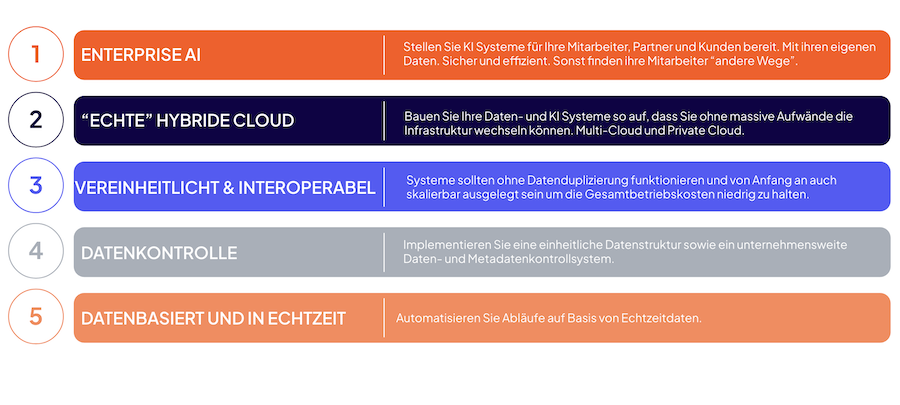The symbiosis of data-driven intelligence
The convergence of data intelligence with other technologies such as the Internet of Things (IoT) and blockchain also opens up new opportunities. For example, a food company could install IoT sensors along the entire supply chain to continuously monitor temperature and humidity, while the blockchain ensures the integrity of this data. Data intelligence systems could then automatically raise the alarm in the event of deviations from optimal conditions or even make adjustments on their own.
Generative AI has a particularly transformative effect on data intelligence. Instead of just analyzing existing data, these systems can now generate original content. For example, a fashion company could feed its sales data into a generative AI system, which then suggests new design variants that match current customer preferences. This ability to not only analyze but also create opens up completely new dimensions of data usage.

Data Operations
The emerging DataOps approach is also revolutionizing the organizational dimension of data intelligence. Similar to DevOps in software development, DataOps improves collaboration between data specialists, developers and specialist departments. A pharmaceutical company could use DataOps to drastically reduce the time from data collection in clinical trials to analysis and decision-making, thereby accelerating drug development.
These developments show that data intelligence is far more than just a technological trend – it represents a fundamental paradigm shift in the way organizations use data to create value and innovate. Companies that skillfully master this transformation will enjoy a decisive competitive advantage in the increasingly data-driven economy.
Business value creation in direct comparison
Consider a healthcare company: With business intelligence, it would generate quarterly reports that break down patient numbers, average treatment costs and common diagnoses by location. These reports help management allocate resources and make budgetary decisions.
With data intelligence, the same company could develop a system that combines patient data, genetic information, lifestyle characteristics and treatment outcomes to create personalized treatment plans. For example, it could predict which patients are at an increased risk of relapse and offer additional preventative care. The system could also identify patterns in drug efficacy in different patient groups and provide doctors with optimized treatment suggestions in real time.
The added value of data intelligence therefore lies not only in efficient data analysis, but also in its ability to enable intelligent, automated and personalized decisions that can be integrated directly into business processes.
Ethical dimensions and trustworthiness
As data usage increases, ethical aspects become more important. Business intelligence has an advantage in terms of traceability thanks to its transparent, rule-based analyses. For example, a financial services provider can clearly show how certain key figures have been calculated and which data points have been included in the analysis. This transparency creates trust among stakeholders and supervisory authorities.
Data intelligence faces major challenges here. The complex algorithms, especially neural networks, often function as a “black box” whose decision-making processes are difficult to understand. An insurance company that uses data intelligence for risk assessment must ensure that no unintentional discrimination occurs and that the basis for decision-making can be explained. Modern data intelligence systems are therefore increasingly integrating explainability components that make algorithmic decisions transparent.
Future prospects for data-based decision-making
The boundaries between business intelligence and data intelligence are becoming increasingly blurred as traditional BI providers expand their platforms to include AI functions. Nevertheless, the conceptual difference remains: Business intelligence helps people make better decisions, while data intelligence increasingly makes and implements decisions itself.
What the future holds
In the future, companies are likely to pursue hybrid approaches – with automated decision-making through data intelligence for operational processes and human-driven strategic decision-making supported by business intelligence. The most successful organizations will be those that intelligently combine both approaches, blending human intuition with machine precision and scalability.
The future belongs to an integrated data strategy in which data intelligence ensures operational excellence, while business intelligence supports strategic decisions. Companies that master this interplay will enjoy a decisive competitive advantage in the data-driven economy and be able to make well-founded decisions based on a deep understanding of their data.
Q&A
What is the difference between big data, business intelligence, business analytics and data intelligence?
Big data, business intelligence and data intelligence are related but different concepts in data management. Big data refers to very large, complex data volumes and the technologies and methods used to process them, which are characterized by high volume, high speed and great variety.
Business intelligence (BI), on the other hand, focuses on analyzing business data to support decision-making processes. BI works primarily retrospectively with structured company data and uses tools such as dashboards and reporting to optimize business processes.
Business analytics goes one step further than traditional BI and uses statistical and quantitative methods to carry out in-depth data analyses. It encompasses a broader range of analytics, from descriptive to predictive to prescriptive analytics. Business analytics aims not only to understand what has happened, but also to predict what could happen and derive recommendations for action.
Data Intelligence is the most comprehensive approach that integrates and extends the other concepts. It combines big data, advanced analytics and AI/ML methods to leverage both structured and unstructured data for forward-looking insights. Data Intelligence focuses on data-driven innovation and strategic decision making by gaining deeper insights and recognizing complex patterns that traditional methods might miss.
The main difference lies in the focus and depth: Big Data concentrates on the technical infrastructure, Business Intelligence on operational business decisions through reporting, Business Analytics on advanced analytical methods for predictions, and Data Intelligence on the comprehensive integration of all these elements for strategic innovation and in-depth insights.
What are the major challenges in data intelligence?
Data quality is fundamental, as inaccurate or incomplete data leads to incorrect analyses. Data integration requires the merging of heterogeneous data from different sources with different formats and structures. Data security and data protection are just as important as technical complexity, tool selection and the lack of experts.
Overcoming organizational silos requires a cross-divisional data strategy. Last but not least, the challenge remains of deriving and implementing measures that actually add value from data-driven findings – the often-cited “last mile” of data intelligence.



